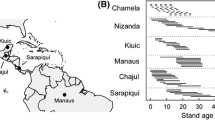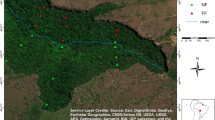Abstract
Tropical rain forest dominated by Peltogyne gracilipes (Fabaceae) occurs on Maracá Island, Roraima, Brazil, on a range of soil types. Three forest types were stratified for sampling, according to the occurrence of Peltogyne trees: (1) Peltogyne-rich forest (PRF), (2) Peltogyne-poor forest (PPF), and (3) forest without Peltogyne (FWP). Biomass increment and change in total stand biomass were calculated from mortality, recruitment, and growth data for trees in the three forest types. Data were derived from permanent plots established in 1991, where all trees (≥10 cm diameter at breast height), including palms and vines (lianas), were tagged and measured in three plots, each of 0.25 ha, in each of the three forest types. Field surveys were carried out in October 1991 and March 2003. Over a period of 11 years, the above-ground biomass in all forest types declined slightly (<5%), associated with the death of large trees, especially in the monodominant forests (PRF and PPF). Within the study period, the forest on Maracá experienced two heavy droughts, related to El Niño events (1997–1998 and 2002–2003) and most mortality and loss of biomass probably occurred during these events. Therefore, as the Maracá forests appear not be increasing in above-ground biomass overall, they may not be acting as a sink for atmospheric CO2. The trees of the five most abundant species (Ecclinusa, Lecythis, Licania, Peltogyne, and Pradosia) accounted for about 55% of the total biomass in both FWP and PPF and for 74% in PRF. Peltogyne gracilipes had a stable, regenerating population in PRF, and is clearly a persistent dominant in a monodominant forest.




Similar content being viewed by others
References
Baker TR, Phillips OL, Malhi Y et al (2004) Increasing biomass in Amazonian forest plots. Phil Trans R Soc Lond B 359:353–365
Barbosa RI, Xaud MR, Silva GFN et al (2003) Forest Fires in Roraima, Brazilian Amazonia. Int For Fire News 28:51–56
Barbosa RI, Fearnside P (1999) Incêndios na Amazônia Brasileira: estimativa de emissão de gases do efeito estufa pela queima de diferentes ecossistemas de Roraima na passagem do evento ‘El Niño’ (1987/8). Acta Amazon 29:513–534
Barbosa RI, Fearnside P (2000) As lições do fogo. Ciência Hoje 157:34–39
Barlow J, Peres CA (2004) Ecological responses to El Niño-induced surface fires in central Amazônia: management implications for flammable tropical Forest. Phil Trans R Soc Lond B 359:367–380
Brown IF, Martinelli LA, Thomas WW et al (1995) Uncertainty in the biomass of Amazonian forests: an example from Rondônia. For Ecol Manag 75:175–189
Brown S (2002) Measuring carbon in forests: current status and future challenges. Envir Poll 116:363–372
Brünig EF (1983) Vegetation structure and growth. In: Golley FB (ed) Tropical rain forest ecosystems. Elsevier, Amsterdam
Chambers JQ, dos Santos J, Ribeiro RJ et al (2001) Tree damage, allometric relationships, and aboveground net primary production in a tropical forest. For Ecol Manag 152:73–84
Chave J, Riera B, Dubois MA (2001) Estimation of biomass in a neotropical forest of French Guiana: spatial and temporal variability. J Trop Ecol 17:79–96
Chave J, Chust G, Condit R et al (2005) Error propagation and scaling for tropical forest biomass estimates. In: Malhi Y, Phillips O (eds) Tropical forests and global atmospheric change. Oxford University Press, Oxford
Clark DB, Clark DA (1996) Abundance, growth and mortality of very large trees in neotropical lowland rain forest. For Ecol Manag 80:235–244
Clark DA, Brown S, Kicklighert DW et al (2001) Measuring net primary production in tropical forest: concepts and field methods. Ecol Appl 11:356–370
Condit R, Hubbel SP, Foster RB (1995) Mortality rates of 205 Neotropical tree and shrub species and the impact of severe drought. Ecol Monogr 65:419–439
Connell JH, Lowman MD (1989) Low-diversity tropical rain forests: some possible mechanisms for their existence. Am Nat 134:88–119
Cummings DL, Kauffman JB, Perry DA et al (2002) Aboveground biomass and structure of rainforests in the southwestern Brazilian Amazon. Forest Ecol Manag 163:293–307
Eidt RC (1968) The climatology of South America. In: Fittkau EJ, Illies J, Klinge H et al (eds) Biogeography and ecology in South America, vol 1. W. Junk, The Hague
Fearnside PM (1997) Greenhouse gases emissions from deforestation in Brazilian Amazonia: net committed emissions. Clim Chan 35:321–360
Fearnside PM (2005) Deforestation in Brazilian Amazonia: history, rates and consequences. Cons Biol 19:680–688
Fearnside PM, Leal Jr N, Fernandes FM (1993) Rainforest burning and the global carbon budget: biomass, combustion efficiency, and charcoal formation in the Brazilian Amazon. J Geophys Res 98(D9):16733–16743
Fragoso JMV, Silvius KM, Correa JA (2003) Long-distance seed dispersal by tapirs increases seed survival and aggregates tropical trees. Ecology 84:1998–2006
Furley P, Dargie TC, Place CJ (1994) Remote sensing and the establishment of a geographical information system resource management on and around Maracá Island. In: Hemming J (ed) The Rainforest edge. Plant and soil ecology of Maracá Island, Brazil. Manchester University Press, Manchester
Houghton RA, Lawrence KT, Hackler JL et al (2001) The spatial distribution of forest biomass in the Brazilian Amazon: a comparison of estimates. Glob Chan Biol 7:731–746
Laurance WF, Fearnside PM, Laurance SG et al (1999) Relationship between soils and Amazon forest biomass: a lansdscape-scale study. Forest Ecol Manag 118:127–138
Lewis SL, Phillips OL, Baker TR et al (2004) Concerted changes in tropical forest structure and dynamics: evidence from 50 South American long-term plots. Phil Trans R Soc Lond B 359:421–436
Lieberman D, Lieberman M (1987) Forest tree growth and dynamics at La Selva, Costa Rica (1969–1982). J Trop Ecol 3:347–358
Malhi Y, Grace J (2000) Tropical forests and atmospheric carbon dioxide. TREE 15:332–337
Malhi Y, Wood D, Baker T et al (2006) The regional variation of aboveground live biomass in old-growth Amazonian forests. Glob Chan Biol 12:1–32
Malhi Y, Wright J (2005) Late twentieth-century patterns and trends in the climate of tropical forest regions. In: Malhi Y, Phillips O (eds) Tropical forests and global atmospheric change. Oxford University Press, Oxford
Meir P, Grace J (2005) The effects of drought on tropical forest ecosystems. In: Malhi Y, Phillips O (eds) Tropical forests and global atmospheric change. Oxford University Press, Oxford
Milliken W, Ratter JA (1998) The vegetation of the Ilha de Maracá. In: Milliken W, Ratter JA (eds) Maracá: the biodiversity of an Amazonian rainforest, John Wiley & Sons Ltd, London
Nascimento EM, Laurance WF (2002) Total aboveground biomass in central Amazonian rainforests: a landscape-scale study. For Ecol Manag 168:311–321
Nascimento MT, Felfili JM, Oliveira-Filho A et al (2000) Queimadas em Roraima: causas e conseqüências para suas florestas. Ciência Hoje 157:40–43
Nascimento MT, Proctor J (1997a) Soil and plant changes across a monodominant rain forest boundary on Maracá Island, Roraima, Brazil. Glob Ecol Biogeog Let 6:387–395
Nascimento MT, Proctor J (1997b) Population dynamics of five tree species in a monodominant forest and two other forest types on Maracá Island, Roraima, Brazil. For Ecol Manag 94:115–128
Nascimento MT, Proctor J, Villela DM (1997) Forest structure, floristic composition and soils of an Amazonian monodominant forest on Maracá Island, Roraima, Brazil. Edin J Bot 54:1–38
Nortcliff S, Robison D (1998) The Soils of the Ilha de Maracá. In: Milliken W, Ratter JA (eds) The biodiversity and environment of an Amazonian rainforest. John Wiley & Sons, Chichester
Philips OL, Gentry AH (1994) Increasing turnover through time in tropical forests. Science 263:954–958
Phillips OL, Baker TR (2002) Field manual for plot establishment and remeasurement. RAINFOR (Amazon Forest Inventory Network), http://www.geog.leeds.ac.uk/projects/rainfor/rainforfieldmanual.doc cited 20 April 2007
Phillips OL, Malhi Y, Higuchi N et al (1998) Changes in the carbon balance of tropical forests: evidence from long-term plots. Science 282:439–442
Rolim S, Jesus RM, Nascimento HEM et al (2005) Biomass change in an Atlantic tropical moist forest: the ENSO effects in permanent sample plots over a 22-year period. Oecol 142:238–246
Seiler W, Crutzen PJ (1980) Estimates of gross and net fluxes of carbon between the biosphere and the atmosphere from biomass burning. Clim Chan 2:207–247
Sheil D, Jennings S, Savill P (2000) Long-term permanent plot observations of vegetation dynamics in Budongo, a Ugandan rain forest. J Trop Ecol 16:765–800
Sheil D, May R (1996) Mortality and recruitment rate evaluations in heterogeneous tropical forest. J Ecol 84:91–100
Stephenson NL, van Mantgem PJ (2005) Forest turnover rates follow global and regional patterns of productivity. Ecol Let 8:524–531
Swaine MD, Whitmore TC (1988) On the definition of ecological species groups in tropical rain forests. Plant Ecol 75:85–86
Swaine MD, Lieberman D, Putz FE (1987) The dynamics of tree populations in tropical forest: a review. J Trop Ecol 3:359–366
Villela DM, Proctor J (1999) Litterfall mass, chemistry and nutrient retranslocation in a monodominant forest on Maracá Island, Roraima, Brazil. Biotropica 31:198–211
Villela DM, Proctor J (2002) Leaf litter decomposition and monodominance in the Peltogyne forest of Maracá Island, Brazil. Biotropica 34:334–347
Williamson GB, Laurance WF, Oliveira A et al (2000). Amazonian wet forest resistance to the 1997–98 El Niño drought. Cons Biol 14:1538–1542
Wright SJ (2005) Tropical forests in a changing environment. TREE 20:553–560
Whitmore TC (1984) Tropical rain forests of the Far East, 2nd edn. Clarendon, Oxford
Zar JH (1984) Biostatistical analysis, 2nd edn. Prentice Hall, New Jersey
Zheng Z, Feng Z, Cao M et al (2006) Forest structure and biomass of a tropical seasonal rain forest in Xishuangbanna, Southwest China. Biotropica 38:318–327
Acknowledgments
We thank Gutemberg Moreno (IBAMA-RR) for logistic support and John Hay, Luiz Eduardo Aragão, Laszlo Nagy, and two anonymous reviewers for comments on the manuscript. National Research Council of Brazil (CNPq) provided financial support and a productivity grant to MTN.
Author information
Authors and Affiliations
Corresponding author
Additional information
John Proctor—Deceased
Rights and permissions
About this article
Cite this article
Nascimento, M.T., Barbosa, R.I., Villela, D.M. et al. Above-ground biomass changes over an 11-year period in an Amazon monodominant forest and two other lowland forests. Plant Ecol 192, 181–191 (2007). https://doi.org/10.1007/s11258-007-9303-z
Received:
Accepted:
Published:
Issue Date:
DOI: https://doi.org/10.1007/s11258-007-9303-z




